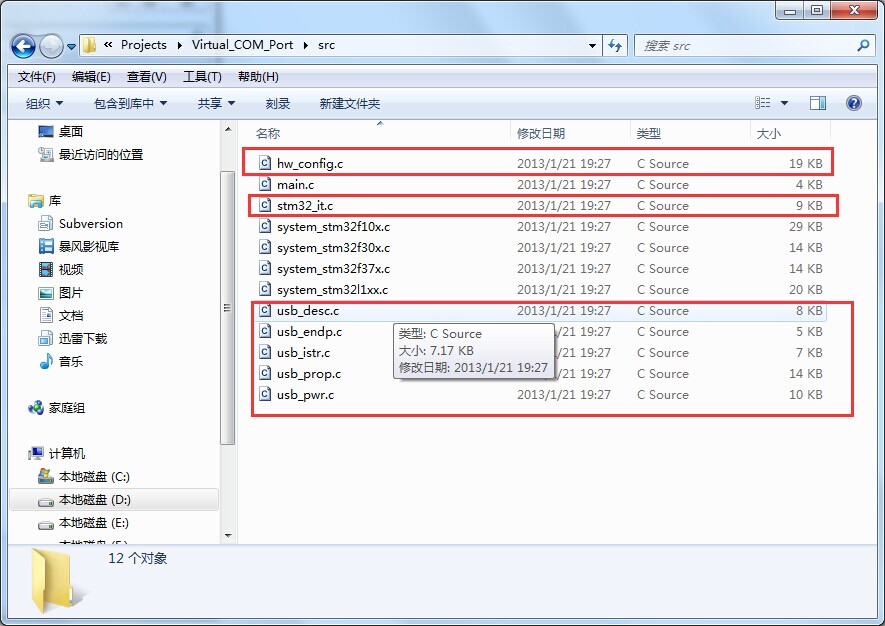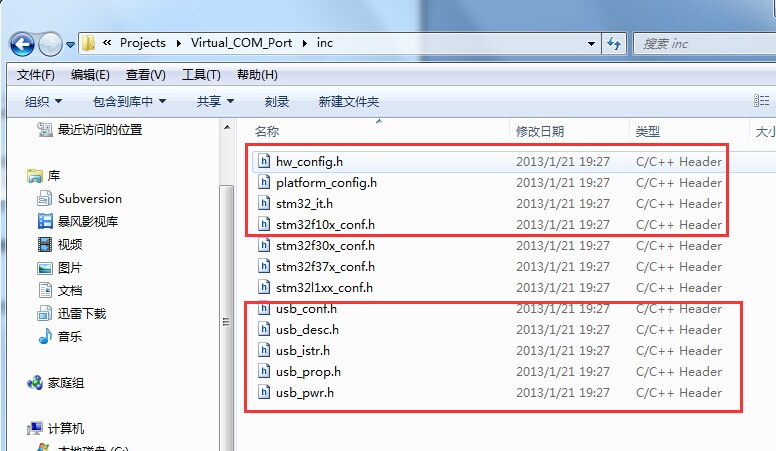源:STM32 USB虚拟串口
串口调试在项目中被使用越来越多,串口资源的紧缺也变的尤为突出。很多本本人群,更是深有体会,不准备一个USB转串口工具就没办法进行开发。本章节来简单概述STM32低端芯片上的USB虚拟串口的移植。在官方DEMO中已经提供了现成的程序,这里对修改方法做简单说明。
官方demo及驱动程序,我存放在百度盘:
http://pan.baidu.com/s/1hq3moE4
首先打开官方demo我们开始进行移植,第一步复制我们可用的文件,操作如下:
Projects\Virtual_COM_Port文件夹下,复制红线部分
图1
图2
我为了方便演示统放在usb/src文件夹下:
图3
现在复制USB的库文件,这些文件不需要我们修改:
图4
上图中的文件统一放在usb/lib文件夹下:
图5
好了现在所需要的文件我们以复制完了。这里先讲一下DEMO程序的主要工作流程:
图6
由上图可知,PC通过虚拟串口发送数据到STM32 usb口,STM32再通过usart1发送数据到PC串口。我们做项目时,只用USB虚拟串口即可。所以我们现在需要把串口发送部分删除。把USB做为一个COM口来使用。我们要如何使用这个USB口呢?demo中是把USB发送数据做了一个缓存,先把要发送的数据存入缓存中,然后由USB自动发送出去。而接收部分是直接通过串口透传。我们在应用时就需要用到两个FIFO,1是发送,这个和demo方式是样;2是接收,接收也做一个缓存,我们通过查询来判断是否收到新数据。这下大家应该明白为什么使用两个FIFO了。 我这里有写好的FIFO库函数可直接使用Queue.c文件。
现在开始修改:
1,stm32_it.c 更名为usb_it.c删除无用代码,只保留usb中断函数,和唤醒函数。代码如下:
代码1
/* Includes ------------------------------------------------------------------*/ #include "hw_config.h" #include "usb_lib.h" #include "usb_istr.h" /******************************************************************************* * Function Name : USB_IRQHandler * Description : This function handles USB Low Priority interrupts * requests. * Input : None * Output : None * Return : None *******************************************************************************/ #if defined(STM32L1XX_MD) || defined(STM32L1XX_HD)|| defined(STM32L1XX_MD_PLUS)|| defined (STM32F37X) void USB_LP_IRQHandler(void) #else void USB_LP_CAN1_RX0_IRQHandler(void) #endif { USB_Istr(); } /******************************************************************************* * Function Name : USB_FS_WKUP_IRQHandler * Description : This function handles USB WakeUp interrupt request. * Input : None * Output : None * Return : None *******************************************************************************/ #if defined(STM32L1XX_MD) || defined(STM32L1XX_HD)|| defined(STM32L1XX_MD_PLUS) void USB_FS_WKUP_IRQHandler(void) #else void USBWakeUp_IRQHandler(void) #endif { EXTI_ClearITPendingBit(EXTI_Line18); }
2,修改代码hw_config.c删除无用代码,新建立2组,读FIFO和写FIFO的函数。后面会用到。
代码如下:
代码2
/* Includes ------------------------------------------------------------------*/ #include "usb_lib.h" #include "usb_prop.h" #include "usb_desc.h" #include "hw_config.h" #include "usb_pwr.h" #include "Queue.h" /* Private typedef -----------------------------------------------------------*/ /* Private define ------------------------------------------------------------*/ /* Private macro -------------------------------------------------------------*/ /* Private variables ---------------------------------------------------------*/ ErrorStatus HSEStartUpStatus; USART_InitTypeDef USART_InitStructure; EXTI_InitTypeDef EXTI_InitStructure; #define USB_COM_RX_BUF_SIZE (1024 + 256) #define USB_COM_TX_BUF_SIZE (1024 + 256) static QUEUE8_t m_QueueUsbComRx = {0}; static QUEUE8_t m_QueueUsbComTx = {0}; static uint8_t m_UsbComRxBuf[USB_COM_RX_BUF_SIZE] = {0}; static uint8_t m_UsbComTxBuf[USB_COM_TX_BUF_SIZE] = {0}; static void IntToUnicode (uint32_t value , uint8_t *pbuf , uint8_t len); /* Extern variables ----------------------------------------------------------*/ extern LINE_CODING linecoding; /* Private function prototypes -----------------------------------------------*/ /* Private functions ---------------------------------------------------------*/ /******************************************************************************* * Function Name : Set_System * Description : Configures Main system clocks & power * Input : None. * Return : None. *******************************************************************************/ void Set_System(void) { GPIO_InitTypeDef GPIO_InitStructure; QUEUE_PacketCreate(&m_QueueUsbComRx, m_UsbComRxBuf, sizeof(m_UsbComRxBuf)); QUEUE_PacketCreate(&m_QueueUsbComTx, m_UsbComTxBuf, sizeof(m_UsbComTxBuf)); /* Enable USB_DISCONNECT GPIO clock */ RCC_APB2PeriphClockCmd(RCC_APB2Periph_GPIO_DISCONNECT, ENABLE); /* Configure USB pull-up pin */ GPIO_InitStructure.GPIO_Pin = USB_DISCONNECT_PIN; GPIO_InitStructure.GPIO_Speed = GPIO_Speed_50MHz; GPIO_InitStructure.GPIO_Mode = GPIO_Mode_Out_PP; GPIO_Init(USB_DISCONNECT, &GPIO_InitStructure); /* Configure the EXTI line 18 connected internally to the USB IP */ EXTI_ClearITPendingBit(EXTI_Line18); EXTI_InitStructure.EXTI_Line = EXTI_Line18; EXTI_InitStructure.EXTI_Trigger = EXTI_Trigger_Rising; EXTI_InitStructure.EXTI_LineCmd = ENABLE; EXTI_Init(&EXTI_InitStructure); } /******************************************************************************* * Function Name : Set_USBClock * Description : Configures USB Clock input (48MHz) * Input : None. * Return : None. *******************************************************************************/ void Set_USBClock(void) { /* Select USBCLK source */ RCC_USBCLKConfig(RCC_USBCLKSource_PLLCLK_1Div5); /* Enable the USB clock */ RCC_APB1PeriphClockCmd(RCC_APB1Periph_USB, ENABLE); } /******************************************************************************* * Function Name : Enter_LowPowerMode * Description : Power-off system clocks and power while entering suspend mode * Input : None. * Return : None. *******************************************************************************/ void Enter_LowPowerMode(void) { /* Set the device state to suspend */ bDeviceState = SUSPENDED; } /******************************************************************************* * Function Name : Leave_LowPowerMode * Description : Restores system clocks and power while exiting suspend mode * Input : None. * Return : None. *******************************************************************************/ void Leave_LowPowerMode(void) { DEVICE_INFO *pInfo = &Device_Info; /* Set the device state to the correct state */ if (pInfo->Current_Configuration != 0) { /* Device configured */ bDeviceState = CONFIGURED; } else { bDeviceState = ATTACHED; } /*Enable SystemCoreClock*/ // SystemInit(); } /******************************************************************************* * Function Name : USB_Interrupts_Config * Description : Configures the USB interrupts * Input : None. * Return : None. *******************************************************************************/ void USB_Interrupts_Config(void) { NVIC_InitTypeDef NVIC_InitStructure; NVIC_InitStructure.NVIC_IRQChannel = USB_LP_CAN1_RX0_IRQn; NVIC_InitStructure.NVIC_IRQChannelPreemptionPriority = 2; NVIC_InitStructure.NVIC_IRQChannelSubPriority = 0; NVIC_InitStructure.NVIC_IRQChannelCmd = ENABLE; NVIC_Init(&NVIC_InitStructure); /* Enable the USB Wake-up interrupt */ NVIC_InitStructure.NVIC_IRQChannel = USBWakeUp_IRQn; NVIC_InitStructure.NVIC_IRQChannelPreemptionPriority = 0; NVIC_Init(&NVIC_InitStructure); } /******************************************************************************* * Function Name : USB_Cable_Config * Description : Software Connection/Disconnection of USB Cable * Input : None. * Return : Status *******************************************************************************/ void USB_Cable_Config (FunctionalState NewState) { if (NewState == DISABLE) { GPIO_ResetBits(USB_DISCONNECT, USB_DISCONNECT_PIN); } else { GPIO_SetBits(USB_DISCONNECT, USB_DISCONNECT_PIN); } } /******************************************************************************* * Function Name : void USB_Config(void) * Description : USB系统初始化 * Input : * Output : * Other : * Date : 2014.11.28 *******************************************************************************/ void USB_Config(void) { Set_System(); Set_USBClock(); USB_Interrupts_Config(); USB_Init(); } /******************************************************************************* * Function Name : uint32_t USB_RxRead(uint8_t *buffter, uint32_t buffterSize) * Description : 从USB接收缓存中读数据 * Input : * Output : * Other : * Date : 2014.11.28 *******************************************************************************/ uint32_t USB_RxRead(uint8_t *buffter, uint32_t buffterSize) { return QUEUE_PacketOut(&m_QueueUsbComRx, buffter, buffterSize); } /******************************************************************************* * Function Name : uint32_t USB_RxWrite(uint8_t *buffter, uint32_t writeLen) * Description : 写数据到USB接收缓存中 * Input : * Output : * Other : * Date : 2014.11.28 *******************************************************************************/ uint32_t USB_RxWrite(uint8_t *buffter, uint32_t writeLen) { return QUEUE_PacketIn(&m_QueueUsbComRx, buffter, writeLen); } /******************************************************************************* * Function Name : uint32_t USB_TxRead(uint8_t *buffter, uint32_t buffterSize) * Description : 从USB发送缓存中读数据 * Input : * Output : * Other : * Date : 2014.11.28 *******************************************************************************/ uint32_t USB_TxRead(uint8_t *buffter, uint32_t buffterSize) { return QUEUE_PacketOut(&m_QueueUsbComTx, buffter, buffterSize);; } /******************************************************************************* * Function Name : uint32_t USB_TxWrite(uint8_t *buffter, uint32_t writeLen) * Description : 写数据到USB发送缓存中 * Input : * Output : * Other : * Date : 2014.11.28 *******************************************************************************/ uint32_t USB_TxWrite(uint8_t *buffter, uint32_t writeLen) { return QUEUE_PacketIn(&m_QueueUsbComTx, buffter, writeLen); } /******************************************************************************* * Function Name : Get_SerialNum. * Description : Create the serial number string descriptor. * Input : None. * Output : None. * Return : None. *******************************************************************************/ void Get_SerialNum(void) { uint32_t Device_Serial0, Device_Serial1, Device_Serial2; Device_Serial0 = *(uint32_t*)ID1; Device_Serial1 = *(uint32_t*)ID2; Device_Serial2 = *(uint32_t*)ID3; Device_Serial0 += Device_Serial2; if (Device_Serial0 != 0) { IntToUnicode (Device_Serial0, &Virtual_Com_Port_StringSerial[2] , 8); IntToUnicode (Device_Serial1, &Virtual_Com_Port_StringSerial[18], 4); } } /******************************************************************************* * Function Name : HexToChar. * Description : Convert Hex 32Bits value into char. * Input : None. * Output : None. * Return : None. *******************************************************************************/ static void IntToUnicode (uint32_t value , uint8_t *pbuf , uint8_t len) { uint8_t idx = 0; for( idx = 0 ; idx < len ; idx ++) { if( ((value >> 28)) < 0xA ) { pbuf[ 2* idx] = (value >> 28) + '0'; } else { pbuf[2* idx] = (value >> 28) + 'A' - 10; } value = value << 4; pbuf[ 2* idx + 1] = 0; } } /************************ (C) COPYRIGHT STMicroelectronics *****END OF FILE****/
这里要讲一下为什么要屏蔽SystemInit(),因为demo只运行虚拟串口功能,在USB未插入的情况下,是进入低功耗状态,插入时从低功耗状态退出后会调用此函数。当然我们在项目中一般不会这样,系统是否运行和插USB接口没有联系。所以我在下文中把进入低功耗代码屏蔽了,自然也就不用唤醒代码了。
图7
关于USB口使能控制引脚,需要根据开发板的引脚定义来修改宏定义platform_config.h文件中,笔者使用的是神舟3号开发板,控制信号刚好和demo相反,所以修改hw_config.c代码如下:
代码3
/******************************************************************************* * Function Name : USB_Cable_Config * Description : Software Connection/Disconnection of USB Cable * Input : None. * Return : Status *******************************************************************************/ void USB_Cable_Config (FunctionalState NewState) { if (NewState == DISABLE) { GPIO_ResetBits(USB_DISCONNECT, USB_DISCONNECT_PIN); } else { GPIO_SetBits(USB_DISCONNECT, USB_DISCONNECT_PIN); } }
3,现在修改USB 回调函数中的代码usb_endp.c文件。使用下文代码替换:
代码4
/* Includes ------------------------------------------------------------------*/ #include "usb_lib.h" #include "usb_desc.h" #include "usb_mem.h" #include "hw_config.h" #include "usb_istr.h" #include "usb_pwr.h" /* Private typedef -----------------------------------------------------------*/ /* Private define ------------------------------------------------------------*/ /* Interval between sending IN packets in frame number (1 frame = 1ms) */ #define VCOMPORT_IN_FRAME_INTERVAL 5 /* Private macro -------------------------------------------------------------*/ /* Private variables ---------------------------------------------------------*/ static uint8_t txBuffter[VIRTUAL_COM_PORT_DATA_SIZE] = {0}; static volatile uint8_t txFlg = 0; static volatile uint32_t FrameCount = 0; /* Private function prototypes -----------------------------------------------*/ /* Private functions ---------------------------------------------------------*/ /******************************************************************************* * Function Name : EP1_IN_Callback * Description : * Input : None. * Output : None. * Return : None. *******************************************************************************/ void EP1_IN_Callback (void) { uint16_t len = 0; if (1 == txFlg) { len = USB_TxRead(txBuffter, sizeof(txBuffter)); if (len > 0) { UserToPMABufferCopy(txBuffter, ENDP1_TXADDR, len); SetEPTxCount(ENDP1, len); SetEPTxValid(ENDP1); FrameCount = 0; } else { txFlg = 0; } } } /******************************************************************************* * Function Name : EP3_OUT_Callback * Description : * Input : None. * Output : None. * Return : None. *******************************************************************************/ void EP3_OUT_Callback(void) { static uint8_t buffter[VIRTUAL_COM_PORT_DATA_SIZE] = {0}; uint16_t USB_Rx_Cnt; /* Get the received data buffer and update the counter */ USB_Rx_Cnt = USB_SIL_Read(EP3_OUT, buffter); /* USB data will be immediately processed, this allow next USB traffic being NAKed till the end of the USART Xfer */ USB_RxWrite(buffter, USB_Rx_Cnt); /* Enable the receive of data on EP3 */ SetEPRxValid(ENDP3); } /******************************************************************************* * Function Name : SOF_Callback / INTR_SOFINTR_Callback * Description : * Input : None. * Output : None. * Return : None. *******************************************************************************/ void SOF_Callback(void) { uint16_t len = 0; if(bDeviceState == CONFIGURED) { if (0 == txFlg) { if (FrameCount++ == VCOMPORT_IN_FRAME_INTERVAL) { /* Reset the frame counter */ FrameCount = 0; /* Check the data to be sent through IN pipe */ len = USB_TxRead(txBuffter, sizeof(txBuffter)); if (len > 0) { UserToPMABufferCopy(txBuffter, ENDP1_TXADDR, len); SetEPTxCount(ENDP1, len); SetEPTxValid(ENDP1); txFlg = 1; } } } } } /************************ (C) COPYRIGHT STMicroelectronics *****END OF FILE****/
这里讲下大概意思,函数EP3_OUT_Callback是在USB口收到数据后,将数据存入FIFO中。
函数SOF_Callback定时查询用户是否有要发送的数据,如果有则进行发送,在发送完成后会触发发送中断EP1_IN_Callback函数,如果发送完毕就不调用SetEPTxValid(ENDP1)函数,发送完成后就不会再触发EP1_IN_Callback函数。
4,修改usb_pwr.c在前文中说到:不让系统进入休眠状态,这里屏蔽185行 __WFI();
5,修改usb_prop.c屏蔽COM初始化代码。137行USART_Config_Default(); 237行USART_Config();
6,修改usb_desc.c 这里修改需要参考一些USB专业的书籍,推荐全圈圈的书,讲的通俗易懂。关于本程序的驱动,笔者在win7下测试可以自动安装,如果无法自动安装可使用文章开始的链接中的驱动程序。本文件如果修改需谨慎,其中pid,vid是制造商ID和产品编号,如果修改了那驱动也要对应修改,官方驱动就无法自动进行安装了。
到这里移植就差不多完成了,下面进行测试。由于USB虚拟串口不受波特率限制,所以笔者进行过50k/s的压力测试,运行半小时未丢1个字节。
移植好的工程STM32_UsbVirtualCom.rar也一起存放在上文章开始的链接中。
